A new valve heater for automotive HVAC system with intelligent power technology
This article refers to the address: http://
Summary
This article is intended to provide a brief introduction to the characteristics of automotive HVAC systems and details how to use an intelligent power driver to control the positioning of the venting valve.
Today, automotive air conditioning ventilation systems have become very popular, and the market demand for HVAC systems has been comparable to the number of factory vehicles.
HVAC systems can be basically divided into three categories: manual air conditioning, semi-automatic air conditioning and fully automatic air conditioning.
These three systems exist in different regional markets and automotive markets.
Ventilation valves for automatic and semi-automatic air conditioners are driven by stepper motors or DC motors.
The purpose of this paper is to analyze the features and benefits of using ST's smart power devices to drive and control electric valves in advanced HVAC systems.
ST's intelligent power driver integrates an SPI bus control stage and multiple protection functions. It integrates 8 or 6 half-bridge circuits in the output stage and can drive DC motors and stepper motors in multiple configurations. The synchronous running motor provides current feedback.
In the new two devices, one integrates a switched-mode power module to control an external boost converter that can simultaneously drive four stepper motors (bipolar motors) or not through boost converters. Drive three stepper motors in sequence. In DC motor applications, these devices can simultaneously drive up to 4 DC motors or drive 7 DC motors in sequence.
In addition, two current monitoring functions using multiplexing technology can detect motor current. With the appropriate external hardware, the signals of these two current monitoring functions can be managed, enabling these drivers to support sensorless position detection algorithms, which saves potentiometers on DC motors.
Foreword
The HVAC system delivers cold or hot air to the cabin, providing a safe, comfortable and relaxing environment for passengers and drivers, improving the visibility of the windows and mirrors, and filtering out pollen from the cabin. , dust and odor.
Recently, we have seen a significant increase in demand for air conditioning systems in small cars. In order to ensure that the car rides as comfortable as the sofa at home, the air conditioning system has become increasingly complex and there are more and more regulations. In fact, modern air conditioning systems divide the interior into four distinct areas, with independent climate control for each area. Therefore, today there is almost no car that does not have a HVAC system. The output of the air-conditioning system is almost equal to the output of the car.
Since the beginning of the installation of air conditioners in the car, a number of improved technologies have increased the complexity of modern air conditioning systems. With the development of air-conditioning systems to semi-automatic air conditioning and full automation, it is predicted that the market share of manual air conditioners will gradually decrease, but considering that manual air conditioners are the preferred solution for economic cars, we can conclude that manual air conditioning systems will not be fast. Delisting. In order to comply with the development trend of the automotive air-conditioning market and meet the needs of automakers for HVAC systems, STMicroelectronics has developed two new intelligent power drivers, L99MD01 and L99MD02, for the application of air-conditioning system ventilation valve positioning motors. The L99MD01 is typically used in high-end air conditioning solutions, while the L99MD02 meets the needs of mid-range air conditioning systems.

New smart power chip that drives the vent valve controller
Air conditioning systems can be divided into three main types: manual air conditioning, semi-automatic air conditioning and fully automatic air conditioning. Ventilation valves for automatic air conditioning systems are controlled by stepper motors or DC motors, depending on the complexity of the system and customer requirements.
A typical venting valve motor configuration uses a DC motor with a built-in potentiometer to perform position detection; another control method uses a unipolar stepper motor. The solution with a stepper motor has one major drawback: five wires are required to connect the venting valve actuator to the electronic climate control unit. Obviously, in order to adjust the temperature quickly and accurately, it is necessary to increase the number of ventilation valves and motors, which will inevitably lead to a large and messy wiring harness on the vehicle. The use of the LIN bus-driven electromechanical control method is a viable solution, but the increase in cost makes this solution only suitable for particularly high-end cars.
The L99MD01 and L99MD02 are able to meet a wide range of customer needs. Both devices are positioned in the mid to premium automotive market, providing complete protection and design flexibility for ventilation valve positioning system developers. Both products are controlled by the SPI bus and incorporate complete diagnostic and protection functions to monitor all outputs.
Stepper motor driven by L99MD01
The L99MD01 is a 6-way half-brake drive that drives stepper motors and DC motors.
When used as a stepper motor driver, the built-in switching power supply module, combined with an external boost converter, can simultaneously drive four stepper motors or three stepper motors in sequence.
This chip saves two lines for each stepper motor that drives the venting valve, reducing the number of lines from five to three. In addition, the L99MD01 can also drive stepper motors with low-cost bipolar windings, saving one winding per phase, thus reducing the number of cables.
Figure 1: Schematic diagram of L99MD01 application
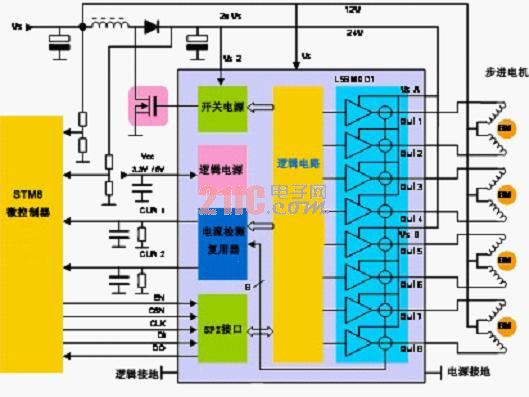
By using the built-in SMPS module, a DC-DC boost converter can be implemented to double the power supply voltage to achieve a symmetrical voltage supply (0V / Vs / 2xVs). The half-bridge circuit is converted to full-bridge operation mode, allowing two-way operation. The current passes through two phases of a stepper motor driven by two half bridges.
In addition, this symmetrical power supply supplies bidirectional current to each phase winding of the stepper motor, requiring only one line per phase, which means that if all motors share a power line, two lines from the control unit can drive a pair. Extreme stepper motor (as shown in Figure 1).
We can see from Figure 2 that the stepper motor driver design using L99MD01 has advantages in terms of wiring and cost.
Figure 2: Stepper motor driving bipolar mode saves wires and costs

Driving DC motor with L99MD0x series
Compared with stepper motors, DC motors are more cost-effective and are the most commonly used control motors in ventilation valve control systems. Both the L99MD01 and L99MD02 products can be used to drive DC valve control systems for DC motor control.
Among the two products, the function and technology of L99MD01 are more complicated, mainly used in the high-end automobile market; the chip integrates 8 half-bridge circuits, which can drive 4 DC motors at the same time or 7 DC motors in sequence, as shown in the figure. 3 and Figure 4.
Figure 3 - L99MD01 drives 4 DC motors simultaneously
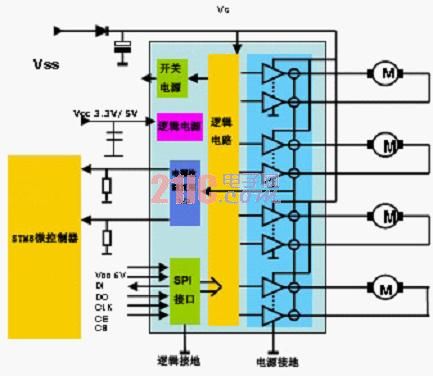
Figure 4 - L99MD01 drives 7 DC motors in sequence
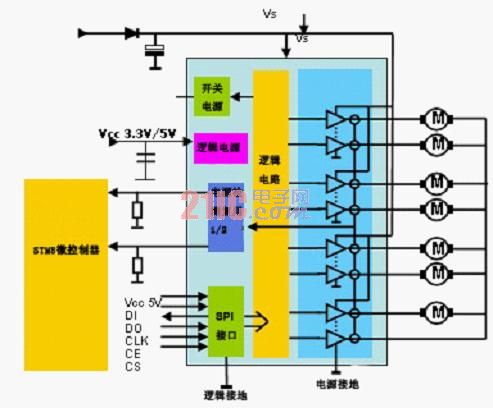
The L99MD02 is a compact version of the L99MD01. The basic structure of the product includes a 6-way half-bridge driver, without the SMPS module for the external boost converter, and the target application is locked in the mid-range automotive air conditioning system market.
L99MD02 has the protection function and features of L99MD01, but can only drive 3 DC motors at the same time or drive 6 DC motors in turn, as shown in Figure 5.
Figure 5 - L99MD02 drives 3 DC motors in sequence

As described above, in an air conditioning system using a DC motor, the position of the venting valve is detected by a potentiometer installed in the motor.
This simple solution requires a power line for each potentiometer, and each potentiometer is connected to the engine control unit. .
With ST's driver and ripple current algorithms, an advanced sensorless venting valve position detection mechanism can be implemented with the benefit of eliminating the need to install potentiometers and associated wiring, helping to reduce overall system cost. In fact, by using the signal sent by the current monitoring pin as an input to the external high/low pass filter, the information needed to detect motor revolutions and vent valve position can be extracted from the pulsating current software processing routine. The signals of the two synchronous current monitoring lines are multiplexed onto different half-bridge outputs, which the microcontroller uses to read back the load current to identify normal and failed conditions. In fact, the current monitoring (CM) pin is responsible for providing the motor's instantaneous mirror current while setting the relevant registers through the SPI interface to adjust the gain in the expected current function (1/250, 1/500, 1/750, 1/1000). Offer possible.
Now we discuss the ripple current counter method, which filters the information obtained from the CM pin by separating the DC portion from the ripple current. The DC section provides load-related information that can be used to estimate the speed of the motor. The ripple current is related to the number of rotor windings, and if properly managed, the ripple current can represent true commutation information. This signal can be used to generate a pulse sequence. The microcontroller then reads the pulse sequence and calculates the number of motor revolutions based on the information read.
Figure 6: DC motor drive circuit with/without potentiometer
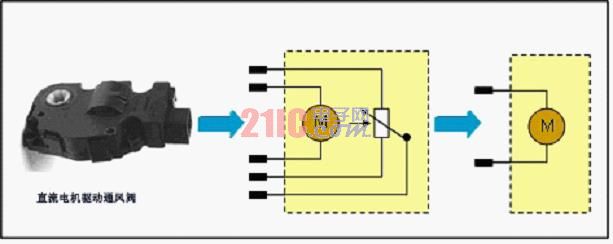
Product features and protection features
The chip contains a 24-bit standard serial peripheral interface (SPI) that controls all of the output pins and manages the chip's communication with the microcontroller. In fact, the chip sends and receives data frames through the SPI, provides the microcontroller with diagnostic information about the state of the chip, and adjusts the different outputs according to the application requirements. The product integrates multiple diagnostic functions including open load, overload, temperature alarm and thermal shutdown detection.
All of these diagnostic functions are internally filtered on the chip: all conditions must remain valid for 32μs in order for the corresponding bit in the status register to be set. The purpose of the insertion filter is to improve the noise immunity of the driver and reduce the complexity of the microcontroller software. Open load and temperature alarms are for informational purposes only and do not change the output state; instead, overload and thermal shutdown disable the corresponding output function or turn off the power to the device.
Both products have built-in cross current protection, which is an important function in the DC motor drive circuit. It is especially important when the motor is commutating. The essence of this function is that after closing a pair of switches in the diagonal direction A delay is applied when turning on the switch tube on the other diagonal line. This delay can prevent the upper arm and the lower arm switch tube on the same bridge arm from being simultaneously turned on.
Composite Suspension Insulator is also referred to as "composite long rod insulators." Suspension Type Insulator has a better mechanical performance and electric performance than porcelain insulators, and the tolerance of safe operation is big, Suspension Insulator is the renew products for electric power line. Electric Composite Suspension Insulator as a substitute for cap-pin insulators and also for critical environmental conditions such as high contamination.
Features
1. Strong explosion protection2. Good hydrophobicity
3. Small weight and unbreakable
4. Easy to identify a damaged unit
5. Suitable for high mechanical tension load,long span and compact power line
Main Technical Parameters
Type
FXBU-15KV
FXBU-25KV
FXBU-35KV
Rated Voltage(KV)
15
25
35
Rated mechanical strength load(KN)
70
70
70
Creepage distance(mm)
445
667
886
Structure height(mm)
352±15
454±15
538±15
Insulating distance(mm)
175
270
358
Lightning impulse withstand voltage(KV)
95
185
200
1 min wet power frequency withstand voltage(KV)
42
75
90
Standard
IEC61109
IEC61109
IEC61109
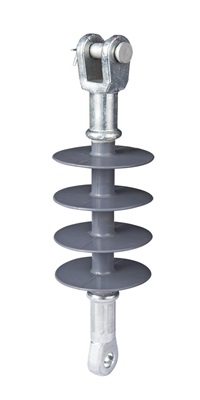
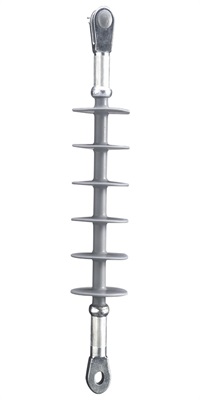

We warmly welcome friends both domestic and abroad to visit our company, if you have any questions, please contact with us directly.
Suspension Composite Insulator
Suspension Insulator,Composite Suspension Insulator,Suspension Type Insulator,Electric Composite Suspension Insulator
FUZHOU SINGREE IMP.& EXP.CO.,LTD. , http://www.cninsulators.com